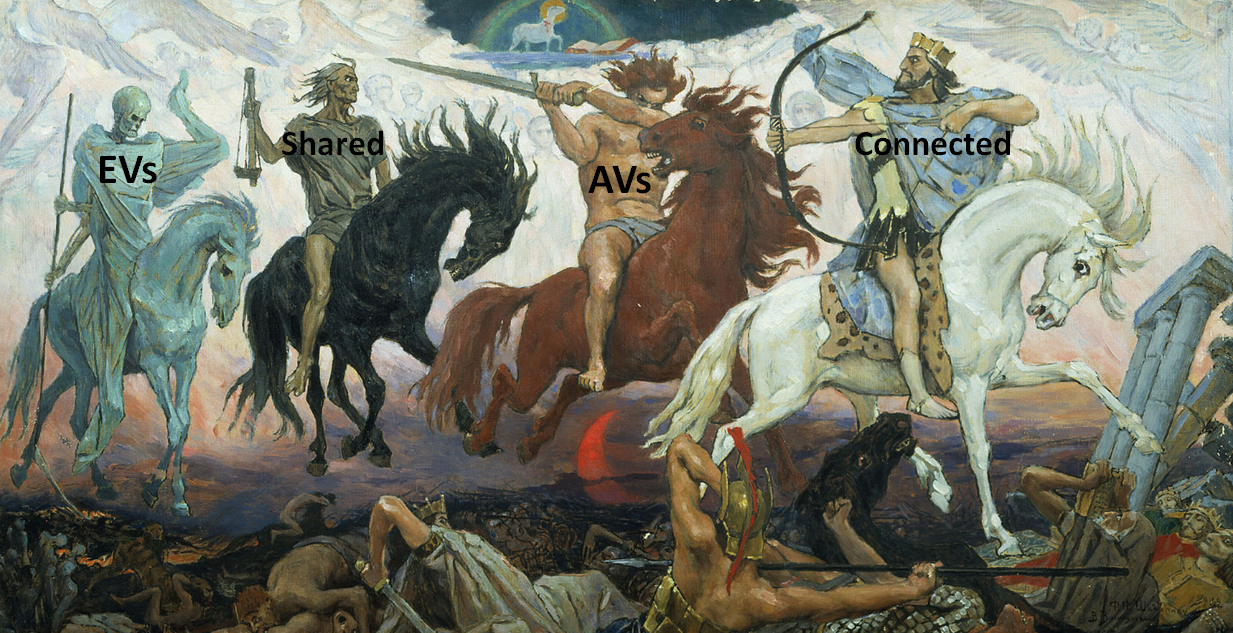
The negative impacts of the coronavirus, COVID-19, on the automotive industry continue to radiate out from the closure of factories and dealerships (for vehicle sales, while service operations continue) to employee furloughs and plunging stock prices. At the same time, the global pandemic has begun to undermine the investment rationale behind four core industry-wide initiatives collectively described as “CASE” or “ACES:” i.e. Connected, Autonomous, Shared, and Electrified driving.
These four sectors are frequently identified at industry conferences – remember when we used to attend those? – as the strategic underpinnings of the future of transportation. Even as the mantra of ACES was being embraced by the industry, though, investment bankers were grumbling at the capital expenditures that were flowing to these R&D and trial endeavors that were producing nothing but rivers of red ink.
Those investment bankers may now be breathing heavy sighs of relief as, one by one, the ACES activities of OEMs appear to be falling by the wayside as enthusiasm wains in the face of pandemic impacts or regulatory authorities lose their nerve. The first “horseman” to fall was autonomous vehicles.
Car companies working on autonomous vehicle solutions, such as General Motors, Ford Motor Company, Daimler, and others, have discovered that making a serious effort in AV development can easily require $250M or more per quarter in non-recoverable expenses. Worse yet, this effort is both technology and labor intensive. There is no easy way to rein in these costs and the development activity takes place in a high risk environment that can literally put lives at risk. Just ask Uber.
It is perhaps no surprise that weeks ago most AV operators in the U.S. – which were using paired human safety drivers and driver monitors, terminated their operations for the duration of the “social distancing” enforcement guidelines in the U.S. The valuations of these companies have correspondingly begun their own curve flattening led by Waymo.
Soon after the shut down of these AV activities reports of financial stress began to emerge from peer-to-peet car sharing operators Turo and Getaround. Only yesterday came news that Penske Corporation was shutting down its Penske Dash car subscription service. Can Free2Move’s U.S. operations be far behind? Does anyone want to share a car these days?
Some analysts thought car share and bike and scooter share operators would benefit from an operating environment in which public transportation was either not available or severely curtailed. The reality has been that all sharing has been severely impacted (weeks ago scooter operators Bird and Lime exited the European market) by an environment suddenly bereft of leisure travelers, high volumes of pedestrian traffic, or social activity of any kind. Stay at home government guidance has almost completely extinguished the sharing economy.
Next to fall was electrification as gasoline prices plunged around the world (below $2.00 in the U.S.) and the U.S. government lowered fuel efficiency targets. European car makers, too, have renewed their opposition to aggressive EU CO2 reduction mandates targeting vehicle emissions. Looks like people have generally lost interest in being environmentally conscious.
The last horseman standing is connectivity. It may well be that connectivity is the sole surviving core automotive technology iniitiative that survives the COVID-19 scourge. The industry may abandon autonomous vehicles, shared vehicles, and electrification – but connectivity seems bound to endure.
It is not as if the motivation doesn’t exist for de-prioritizing connectivity. Car companies committing to connecting their cars know they are taking on a nine-figure investment with an uncertain return. But compared to the hundreds of millions of dollars require to support autonomous vehicle, electric vehicle, or shared vehicle development, $100M to set up and maintain a connected vehicle platform looks like a rounding error.
The automotive industry is poised on the threshold of 5G adoption which will bring vehicle-to-vehicle, vehicle-to-infrastructure, and vehicle-to-pedestrian communications into being. Higher speed, longer range, and more reliable vehicle connections will set the stage for advanced cybersecurity and software update solutions as well as improved vehicle location information and collision avoidance.
Not even COVID-19 can stand in the way of the movement to connect cars. For the foreseeable future, the pandemic will continue to wreak havoc with autonomous, electrification, and sharing. Car connections will survive even this apocalypse.
Share this post via:





The Quantum Threat: Why Industrial Control Systems Must Be Ready and How PQShield Is Leading the Defense